Tuniq Ripper 1000W Power Supply
Jun 16th, 2009 | By Anthony
Tuniq Ripper 1000W Power Supply
Date
: 06/16/09 – 06:12:07 PM
Author
:
Category
: Power Supplies
Page 1 : Introduction
Manufacturer
: Tuniq
There was a time not too long ago that cheap was a fairly damning way to describe a power supply. Cheap was synonymous with instability, system failure, poor components and if you were really lucky, a grand finally complete with smoke, lights and the oh so distinct smell of bunt electronics. Nowadays however more and more manufacturers are figuring out how to keep the price of their units at an absolute minimum while, keeping the magical smoke inside- Antec's Earthwatt series, Corsair's TX series just to name a few. Where however does the consumer turn for an affordable power supply that also heavier system loads? For a system built with the absolutely latest cutting edge hardware; a pair of nVidia GTX 295s, a tall stack of hard drives and so on, perhaps a power supply unit belonging in the range of a kilowatt would be a more appropriate choice.

Over the past years, Tuniq has shared moderate popularity with larger manufacturers, most notably with the Tuniq Tower CPU cooler. Tuniq may be better known by their parent company: Sunbeam. Though not particularly well known, Tuniq has for a few years now been putting together cases, cooler, other accessories and of course power supplies. Accordingly the star of today's review is Tuniq's flagship power supply, the Tuniq Ripper 1000W.

With an absolute abundance of great units available today, what does the Tuniq offer? Price. Manufacturers big and small have for the past few years been battling it out with one another with performance, features, market niches and absolutely anything else that could give them an edge. We've seen our fair share of new comers to the power supply game, and we've also seen our fair share of those who have walked away. Only recently has the dust begun to settle, and with those still standing reluctant to play their last price card, Tuniq enters with the Ripper series. With a quick scan of major online component retailers, it is plenty obvious that after by default after omitting the clearly too- good- to be- true units, the Tuniq Ripper is among one of the cheapest 1000W units out there today.
Page 2 : Features and Specifications
As always, let's start with features. Here is what Tuniq has to say about the Ripper 1000W:

Having a look at specifications:

Nothing too out of the ordinary, the 140mm fan is a nice touch, and the double ball bearing will definitely help prolong the fan's usage. The off- line cooling referred to by Tuniq is a system where the fan keeps running even after the system powers down until the unit is cool.

The Ripper 1000W is a quad 12V rail unit, 20A and 20A on rails one and two and 30A on both rails three and four for a combined total of 900W maximum load throughout. The 5V and 3.3V rails provide a combined total of 180W.

With connectors, we have a fairly typical assortment; I would however like to see more SATA connectors. Six would be fine for most systems, but a 1000W power supply isn't for most systems. Tuniq, aware of this issue has included adaptors which we will look at later.
Page 3 : Package and Content
The Ripper 1000W comes packed in a black cardboard box, with the outsides decorated with product pictures, system specifications, features and so on.
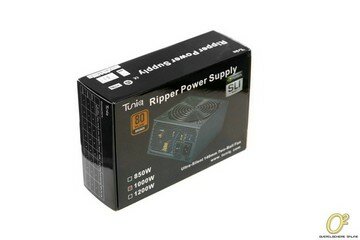
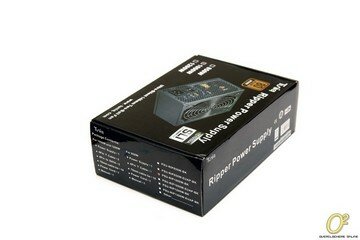
On the back, more product information.
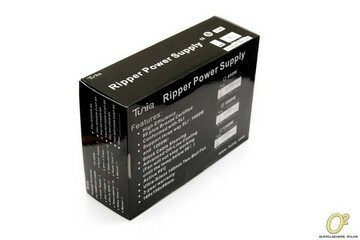
Inside along with the power supply, we get a box of accessories; power cable, zip ties, screws and SATA power connector adaptors.
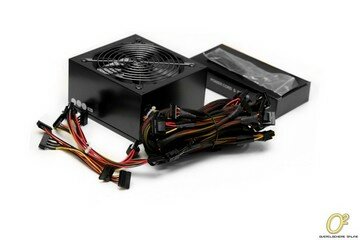
The Ripper 1000W is finished in a clean matte charcoal/ black with matching accents in a dark chrome for the fan grill. The cables are sleeved and finished with black heatshrink as well. Simply, but undeniably subtle and it looks good.
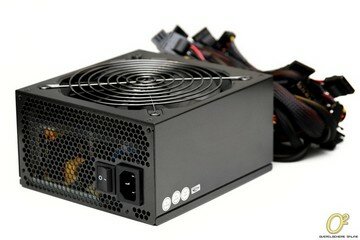
The large 140mm fan on the bottom of the unit should do an excellent job acting as an exhaust for the computer system, and cooling the power supply by drawing air from the case into the power supply and then through the perforated black end.
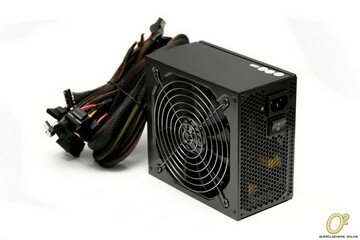
By anyone's count, 1000W is a lot of power, and you better believe Tuniq intends for it to all be put to use! Let's have a look at the connectors equipped with the Ripper 1000W.
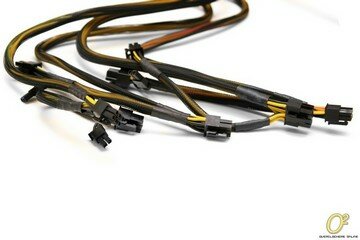
Starting with the PCI- Express connectors, the Ripper 1000W comes with a grand total of six, three of which are the typical six 6 pin PCI- Express connectors, and three of which are 6+2 pin PCI- Express connectors. Of course, there is absolutely no way of putting to use all six connectors, and from a design point of view, modular attachments for the extra PCI- Express connectors would have made a lot of sense here. Still though, minor and no points should be taken away for this.
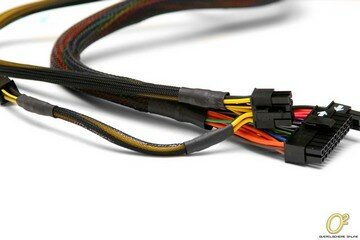
Next, we have the 20+4 pin ATX connector, 8 pin EPS connector and 4 pin motherboard connector.
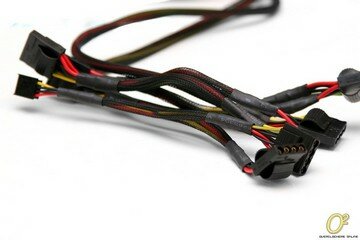
For peripherals, we have two leads of 4 pin connectors, one of which is topped off with a floppy power connector for those odd times when a floppy drive is needed.
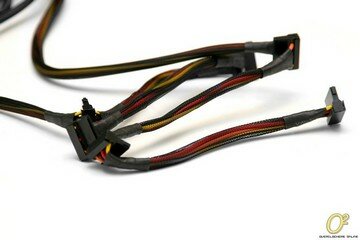
Finally, our six SATA connectors. Three to a lead, and two leads in total.
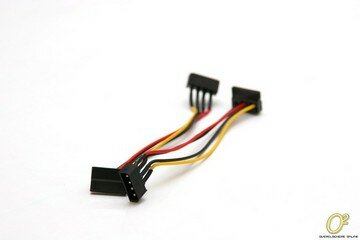
With the included 4 pin power connector to SATA power connector, the Ripper has an actual total of 8 SATA connectors.
Next, let's have a look inside.
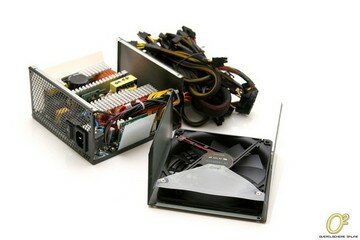
Although the specific design isn't like any other power supply we have seen, the layout is similar to a great number of other units. On the primary and secondary sides we have a number of Rec branded capacitors. Good or bad, only time will tell, this is the first we have encountered these.
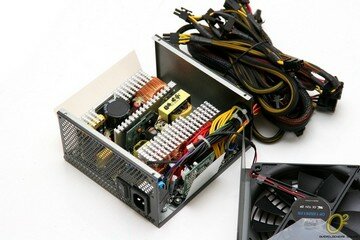
Page 4 : Testing Setup
Quite unlike any other PC component, properly evaluating a power supply involves much, much more than running a battery of tests or sitting down in front of a shooter for a few hours armed with a pen and a pad of paper. Although, we have the utmost appreciation for a few headshots coupled with explosions, power supply reviews call for much more. The general mantra for testing power supplies tends to fall somewhere in the ranges of loading the power supply up to the top, and letting it suffer. We here at Overclockers Online are inclined to agree. Accordingly, our testing methods have evolved to allow for more sophisticated and accurate testing.

The dilemma here is: how to test a power supply without a computer system, but emulate a computer system? It is important to not forget that as much as we try to part from throwing a power supply into a computer system and watching how it performs, ultimately, what we are distancing ourselves from is precisely what we are trying to replicate. Simply, the ideal testing platform would be indistinguishable from a computer system, but graced with the accuracies of an adjustable load. However, since we do not have access to state of the art testing equipment, or the funds to purchase such equipment, we have built a custom load tester. While it does not offer adjustments in the thousandths of a decimal place, it does offer enough flexibility to test current day power supplies and beyond.

Using thick high quality 16AWG wires throughout and equally high quality connectors and switches, we have sought to minimize resistance in the lines while maintaining flexibility. All it takes is a flip of a switch to turn a desired resistor on or off.

A proper electronic load is a start, but we are going to be a bit more ambitious. A keystone piece of our testing mythology is the heat box. A system drawing 800W from a power supply produces quite a bit of heat, and to be testing such a power supply in an ambient environment is not only inconsistent with in-system applications but unrealistic and misleading. Our hotbox consists of nothing more than a case graciously donated to us from Silverstone. Recycling heat produced from the load tester using a series of controlled fans and a duct, we can control operational temperatures and push a power supply to its limits, or over.

Using the heat and load, we will run a battery of five tests: three cold and two hot tests. The three cold tests consist of 50% load, 80% load and finally full load. Naturally, we will escalate the strain on the unit by adding heat in the hot tests. The final two tests are 80% load and full load at approximately 50°C or more.

While the purpose and effects of 'burn in' are debated, doing so causes no harm. Prior to any testing, all units are run for a maximum period of one week without load. At best, this will stabilize the unit; at worst it takes a few hours off the unit's total life span.


In our tests, we will do our best to adhere to ATX specifications including cross loading and criteria for testing. The presentations of our results are designed for ease of interpretation and conciseness.

So, without any further delay, let us get started!
Page 5 : Testing
The aim of the cold test is to reflect ideal operational conditions where heat from the computer system is independent from the power supply. Still though, the term cold test would be misleading as things do get quite hot!
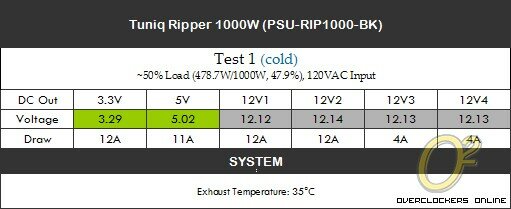
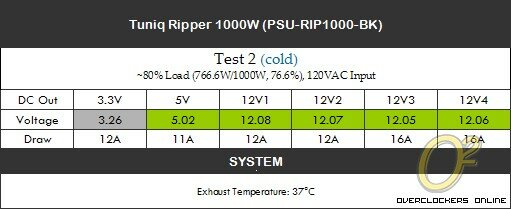
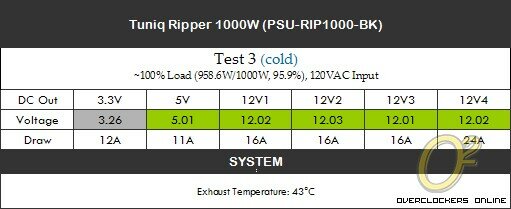
With our first set of tests, the Ripper 1000W does look good. With our first test, 50% load all the 12V rails started off a bit high, with 12V2 reaching 12.14V. As we progressed, the 12V rails leveled out, however the 3.3V rail started to fall. By Test 3, the 3V rail hit 3.26, which isn't bad by any means, but it is worth noting.
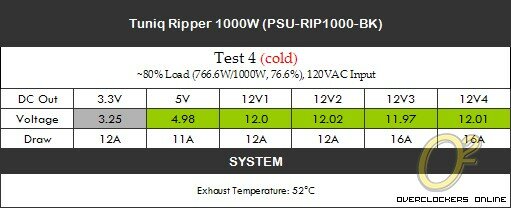
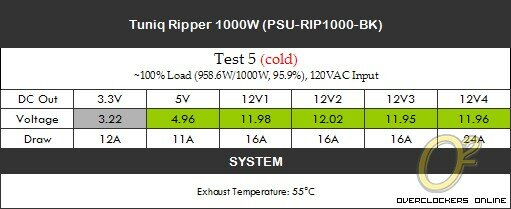
With the heat turned on, rails continued to drop off a bit more. The 5V and 12V rails evened out at their respective targeted output levels, while the 3.3V rail continued to fall. This time however, by Test 5, fell to 3.22V which is just above a 3% deviation away from 3.3V.
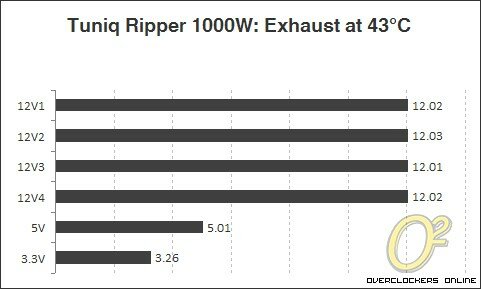
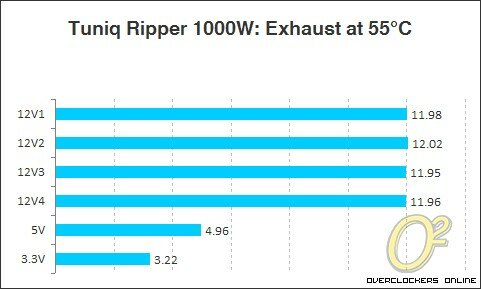
Our final look at testing will be to compare the Ripper 1000W at full loads under the conditions inside and outside the hot box.
With heat going through the system, the rails of course drop off a bit, but the unit still showed some fairly solid line regulation. The internal temperature hit a high of 55 degrees Celsius which is hot, but atypical of high end computer systems.
Page 6 : Conclusion
So, time to wrap this up. The Ripper 1000W is an interesting bundle, there are a lot of things it is, but a lot of things that it isn't. It would be unfair to liken the Riper 1000W to the de-facto budget- high end power supplies like the Earthwatt and Corsair TX series, because, well it isn't. Where the Ripper 1000W shares the spotlight is with the price tag. That isn't to say the Ripper 1000W performed poorly however. The Ripper 1000W is an interesting product and I have no doubt it has earned itself a respectable standing among the others of similar wattage and if for nothing else, again price. But the Ripper 1000W has more to offer than a generous price tag.
We'll start with what Tuniq has done right. The Ripper 1000W is a good looking unit; clean finish, sleeved cables with matching heatshrink, connectors and fan grill. The unit comes with plenty of molex connectors and the cables have quite a bit of length in them. In terms of performance, the Ripper finds itself placed comfortably in the middle of the pack- while there are better units available, it outperforms plenty others. Still, all around good performance. For all that the Ripper excels with; there are a few notable short comings. My primary concern is with the choice of component while we have no reasonable way of gauging longevity of the unit, components used is more often than not a fairly solid indicator. The Ripper 1000W is populated by REC capacitors, from the TREC brand, neither known for quality, nor known for inferiority but higher end units tend to appropriately select higher end, proven components. Another issue I had with the Ripper 1000W was the persistent continual emitting from none other than the enormously- large 140mm fan which is odd. Larger fans are capable of pushing more air, and at slower speeds thus it would be intuitive progression to conclude that larger fans are quieter, but this however is not the case here.
I hate to sound like I am droning on, but we have to again take in account price. For about $150, what the Ripper 1000W offers does look quite appealing and for its short list of short comings, even more so. We have looked at a number of 1000W units; some of the best, some great units, some mediocre, and maybe some forgettable. For the Tuniq Ripper 1000W, all things taken account takes a niche spot and depending on for far your wallet extends will place somewhere between mediocre and great. For anyone looking for a solid 1000W unit without an 'I'll just stop eating for a month' price tag, the Tuniq Ripper 1000W might just fit the bill.

Advantages
- Did I mention price?
- Good performance
- Sleeved
- Lots of cables, lots of connectors
Disadvantages
- Loud
- Internal build
Overclockers Online would like to thank Tuniq for making this review possible.
[...] this review it seems pretty good… They're no JG, but they passed it through the basics and it passed [...]